Teaching and learning in grades 4-8
Winston Churchill once said, “Success is not final, failure is not fatal: It is the courage to continue that counts.” Education author and consultant Barbara Blackburn looks at ways teachers can help young adolescents follow Churchill’s advice and become resilient.
As teachers go about shifting their co-teaching language to promote collaboration and a professional growth mindset, there are some communication situations that just scream “watch your thoughts,” says co-teaching coach Elizabeth Stein. She identifies five.
Teacher-author Roxanna Elden has prepared “a completely unscientific, non-research-based guide” to six common teacher nightmares. They may sound all too familiar to fellow educators. See if she’s analyzed a dream you recognize and share another of your own.
In “Get Organized!” Frank Buck offers a fast, functional read to help all educators get and stay organized. It will be a favorite go-to manual for any school leader eager to increase the most valuable resource in education – time, says ASCD Emerging Leader Michael Janatovich.
In their follow-up to Notice & Note, Kylene Beers & Robert Probst consider the importance of stance, the power of signposts & the role of strategies in helping students become effective readers of nonfiction in every subject. Teacher Linda Biondi celebrates their success.
A steady flow of new district teaching resources is creating a more-than-you-can-eat buffet effect for 4th grade teacher Mary Tarashuk. Take the new online math program. Can she manage to put together the right selection of new dishes and old favorites?
Matt Renwick recommends The Principal 50 by Baruti Kafele to principals and AP’s just transitioning from the classroom to the front office. The book’s 50 topics range from a leader’s attitude to school culture, instructional leadership, accountability and more.
You know those times where the kids are so spun up that you suspect nothing you say will be remembered tomorrow? You ask yourself, “Why am I even trying to teach today?!” Veteran educator Patti Grayson casts her votes for the most inattentive days of the year.
In this “faux” research study, Kevin Hodgson describes the four widely varied 6th grade classes he has this year. His field research reveals four cohorts: The Silent Squad, The Questioning Crowd, The Chatterboxes, & The Selfies. Do any of these sound familiar?
FDR’s “Four Freedoms” speech in 1941 versus Donald Trump’s debate performances this year: meaningful connection or unfair comparison? Sarah Cooper describes her recent lesson and presents her new ground rules for history and current event mashups.






































